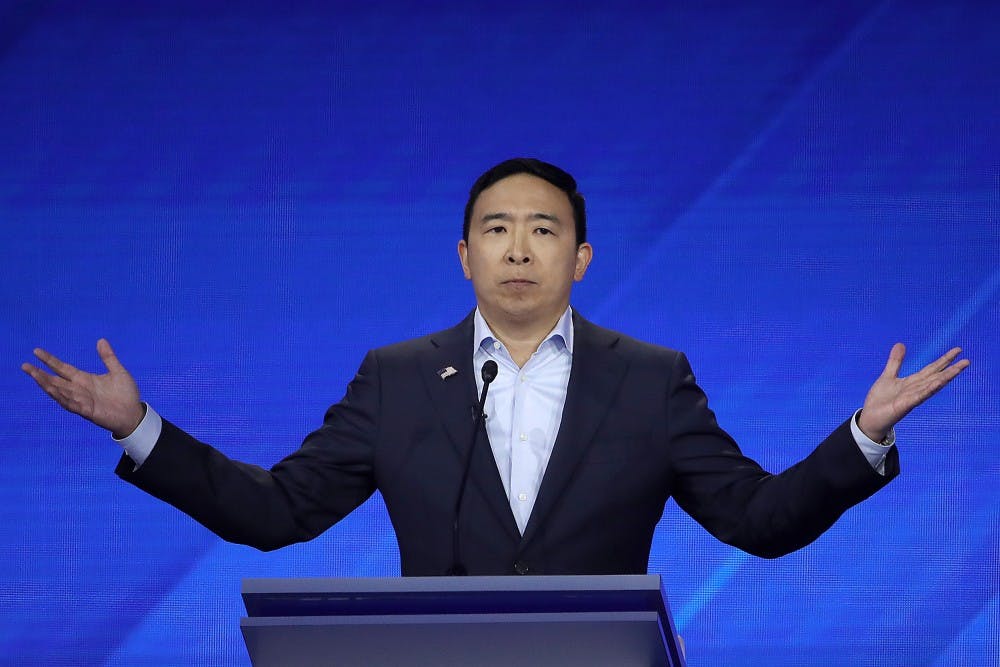If you want to support Andrew Yang’s presidential run, you may opt for one of the t-shirts or hats that he is selling with the word "MATH" emblazoned on the front. Or, if you have been following his debate performances, you may have heard the sentence, “Now, I am Asian, so I know a lot of doctors.”
Yang’s use of merchandise and sayings that play into the stereotype that all Asian Americans are good at math or in extremely academic-focused careers perpetuates the model minority myth.
The model minority myth is harmful to having a strong and united community.
The term model minority is used to refer to a minority group that is perceived as successful, especially in relation to certain minority groups.
Professor Brandon Yoo, an associate professor of Asian Pacific American studies, said the model minority myth started around the civil rights movement and was centered around structural inequality.
“If there is structural racism then why are Asian Americans doing so well?" Yoo said. "That’s where the model minority myth rose, that Asian Americans worked harder than other minorities and that’s what set them apart. It was a myth created to create a rift between Asian Americans and other minorities so that the white men could stay in power.”
This is especially important in Arizona because, as the Asian Pacific Community in Action found that Arizona's Asian American population has doubled since 2000 and it is increasing more than any other racial group.
However, a fall 2018 Facts at a Glance report from the University shared that in 2018 only 7.4% of undergraduate on-campus students are Asian, not including international students. This shows that although the population is growing and becoming a larger demographic, it has not translated to the college environment.
“We have a large selective integration of diverse Asian Americans that already have the resources in terms of higher education or income or wealth," Yoo said. "So, they already came in with the education, it’s not that they worked hard for it, it’s that they came here for it because those were the only Asian Americans that were allowed to come in."
ASU is a school that prides itself on its diversity and inclusion.
However, diversity means nothing without an effort to bring people of diverse backgrounds together.
Nellie Tran, an associate professor at San Diego State University, said in an academic article that we must break down barriers put in place by a need for white supremacy, and we must include Asian American and Pacific Islander narratives in the overall conversation surrounding people of color.
If we do this, it will show a united front against issues affecting minorities today, such as the Black Lives Matter movement and the issues around immigration.
Not only does the model minority myth serve to increase the rift between various minority groups, it also exacerbates feelings of internalized racism and pressure within minorities themselves.
Growing up as an Indian American, I was constantly reminded that I was supposed to be good at math, often from my peers at school which was predominantly white but also by teachers and other authoritative forces in my life.
“When whites endorse the model minority myth, those white college students are actually more likely to be racist towards Asian Americans and have more uncomfortable interactions with Asian Americans,” Yoo said. “The psychological impact of the model minority myth that some may see as a ‘good stereotype’ actually tend to have negative psychological impacts.”
As a community, working to combat the model minority myth reshapes the way we think about race. When Asian Americans, like Andrew Yang, perpetuate this myth alongside many members of ASU’s community, they further this notion that there is a minority that is superior to others while failing to understand the Asian American community as one that is diverse in its strengths and not devoid of weakness.
As this myth continues to exist, the white supremacy it was borne from continues to thrive. Dispelling the model minority myth will take the entire ASU community, but it will strengthen ASU's unity and add real meaning to the diversity ASU prides itself on.
Reach the columnist at alshah2@asu.edu or follow @aasheeni on Twitter.
Editor’s note: The opinions presented in this column are the author’s and do not imply any endorsement from The State Press or its editors.
Want to join the conversation? Send an email to opiniondesk.statepress@gmail.com. Keep letters under 500 words and be sure to include your university affiliation. Anonymity will not be granted.
Like The State Press on Facebook and follow @statepress on Twitter.




